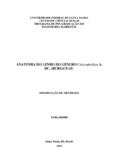| dc.creator | Baldin, Talita | |
| dc.date.accessioned | 2015-05-29 | |
| dc.date.available | 2015-05-29 | |
| dc.date.issued | 2015-02-24 | |
| dc.identifier.citation | BALDIN, Talita. WOOD ANATOMY OF THE Calycophyllum A. DC GENUS (RUBIACEAE). 2015. 136 f. Dissertação (Mestrado em Recursos Florestais e Engenharia Florestal) - Universidade Federal de Santa Maria, Santa Maria, 2015. | por |
| dc.identifier.uri | http://repositorio.ufsm.br/handle/1/8755 | |
| dc.description.abstract | The Rubiaceae family is one of the main botanical families of Flowering Plants Dicotyledonous, being the fourth with the largest number of representatives and, even being cosmopolitan, their species are preferably the warmer regions. Since its original description, the family went through some taxonomic changes because of their significant morphological diversity. The study of species of the genus Calycophyllum A. DC. (C. spruceanum f. brasiliensis, C. candidissimum, C. multiflorum e C. spruceanum) aims to provide information about anatomical characters of taxonomic value, recognize the affinity of anatomical groups, comparing the species and investigate the relationship between anatomy and wood technology. The wood samples were gained from different scientific institutions, such as the Jodrell Laboratory (Kew Gardens, London), the Institute of Technological Research of the State of São Paulo (IPT) and the German University Black Forest Academy (BFA). The cutting blades and macerate were obtained by using the standard technique (BURGER; RICHTER, 1991) and the modified method of Franklin (KRAUS; ARDUIN, 1997), respectively. The wood descriptions were performed in the wood anatomy lab, Federal University of Santa Maria, and followed the recommendations of the IAWA Committee (1989). The cluster analysis included anatomical characters of the species described in this study and also those of other species of Rubiaceae described in the literature. Most anatomical characteristics agreed with the common pattern described in the Rubiaceae family, and allowed grouping them in the wood structure type II. These characteristics however, did not match with the anatomical pattern of the Ixoroideae subfamily. The cluster analysis recognized four main groups. The species of the genus Calycophyllum formed highly similar grouping with each other, which indicates a large structural homogeneity of their woods, more likely due to the high number of shared anatomical features. It is assumed that the anatomical characteristics of wood species investigated confer to the timber high specific gravity, resistance to mechanical stress, low shrinkage, permeability and good natural durability. | eng |
| dc.description.sponsorship | Conselho Nacional de Desenvolvimento Científico e Tecnológico | |
| dc.format | application/pdf | por |
| dc.language | por | por |
| dc.publisher | Universidade Federal de Santa Maria | por |
| dc.rights | Acesso Aberto | por |
| dc.subject | Anatomia da madeira | por |
| dc.subject | Taxonomia | por |
| dc.subject | Rubiaceae | por |
| dc.subject | Wood anatomy | eng |
| dc.subject | Taxonomy | eng |
| dc.subject | Rubiaceae | eng |
| dc.title | Anatomia do lenho do gênero Calycophyllum A. DC. (Rubiaceae) | por |
| dc.title.alternative | Wood anatomy of the Calycophyllum A. DC genus (Rubiaceae) | eng |
| dc.type | Dissertação | por |
| dc.description.resumo | Rubiaceae é uma das principais famílias botânicas das Angiospermas Dicotiledôneas, sendo a quarta com o maior número de representantes e, ainda que cosmopolitas, suas espécies encontram-se, preferencialmente, nas regiões mais quentes do globo. Desde sua descrição original a família passou por algumas mudanças taxonômicas, em razão da expressiva diversidade morfológica de suas espécies. O estudo de espécies do gênero Calycophyllum A. DC. (C. spruceanum f. brasiliensis, C. candidissimum, C. multiflorum e C. spruceanum) visa a fornecer informações a respeito de caracteres anatômicos da madeira de valor taxonômico, formar grupos de afinidades anatômicas, comparar as espécies, bem como investigar a relação entre a anatomia e a tecnologia da madeira. O material analisado é proveniente de diferentes instituições científicas, tais como o Jodrell Laboratory (Kew Gardens, Londres), o Instituto de Pesquisas Tecnológicas do estado de São Paulo (IPT) e a Universidade alemã Black Forest Academy (BFA). Para a obtenção de lâminas histológicas e de macerado utilizou-se respectivamente, a técnica padrão (BURGER; RICHTER, 1991) e o método de Franklin modificado (KRAUS; ARDUIN, 1997). As descrições anatômicas foram realizadas no Laboratório de Anatomia da Madeira da Universidade Federal de Santa Maria e seguiram as recomendações do IAWA Committee (1989). Na análise de agrupamento foram utilizados caracteres anatômicos do lenho das espécies descritas no presente estudo, e também os de outras espécies de Rubiaceae, descritas na literatura. A maior parte das características anatômicas concorda com o padrão típico das Rubiaceae, e permite agrupá-las na estrutura de lenho denominada tipo II, porém discorda do padrão anatômico referido para a subfamília Ixoroideae. Conforme análise de agrupamento, quatro grupos principais foram reconhecidos. As espécies do gênero Calycophyllum formaram agrupamentos altamente semelhantes entre si, o que remete a uma grande homogeneidade estrutural de suas madeiras, reflexo do elevado número de caracteres anatômicos compartilhados. É pressuposto que as características anatômicas do lenho das espécies investigadas, conferem à madeira uma alta massa específica, resistência a esforços mecânicos, baixa contração volumétrica, permeabilidade e boa durabilidade natural. | por |
| dc.contributor.advisor1 | Marchiori, José Newton Cardoso | |
| dc.contributor.advisor1Lattes | http://buscatextual.cnpq.br/buscatextual/visualizacv.do?id=K4788373U5 | por |
| dc.contributor.referee1 | Denardi, Luciano | |
| dc.contributor.referee1Lattes | http://buscatextual.cnpq.br/buscatextual/visualizacv.do?id=K4760086U2 | por |
| dc.contributor.referee2 | Santos, Sidinei Rodrigues dos | |
| dc.contributor.referee2Lattes | http://buscatextual.cnpq.br/buscatextual/visualizacv.do?id=K4138965T1 | por |
| dc.creator.Lattes | http://lattes.cnpq.br/3775067422694277 | por |
| dc.publisher.country | BR | por |
| dc.publisher.department | Recursos Florestais e Engenharia Florestal | por |
| dc.publisher.initials | UFSM | por |
| dc.publisher.program | Programa de Pós-Graduação em Engenharia Florestal | por |
| dc.subject.cnpq | CNPQ::CIENCIAS AGRARIAS::RECURSOS FLORESTAIS E ENGENHARIA FLORESTAL | por |


